Sciatica Exercises: The 4 Best Exercises
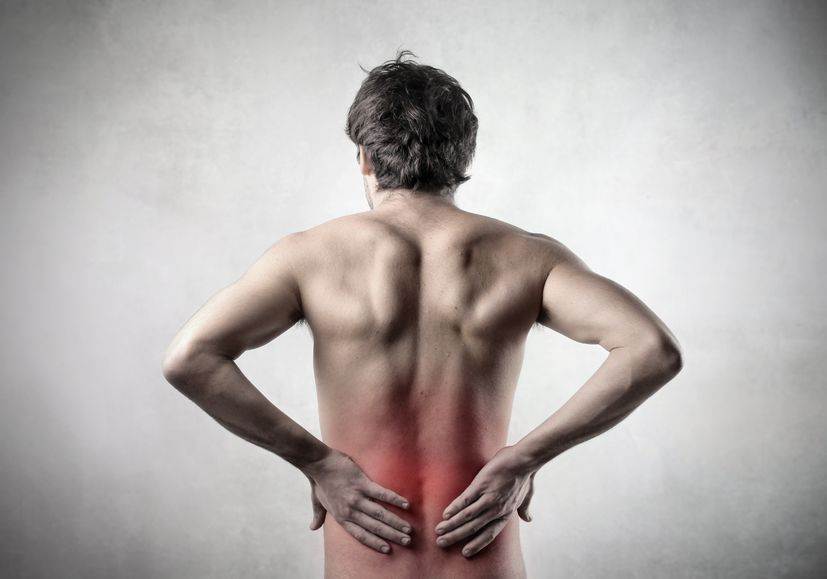
Discover the Best Sciatica Exercises for Pain Relief and Recovery
Persistent sciatica pain can transform daily activities into daunting tasks, leaving you searching for relief. If you’re on the hunt for effective strategies to alleviate sciatica and bolster your rehabilitation, welcome to your comprehensive guide. Here, we delve into not only the treatment options but also spotlight sciatica exercises that are crucial for pain relief and recovery. These exercises, when integrated with the professional care from your chiropractor or physiotherapist, are designed to reduce sciatica symptoms significantly.
Why Focus on Sciatica Exercises?
Exercises specifically tailored for sciatica play a pivotal role in managing and reducing pain. They are essential for strengthening the muscles supporting your spine, improving flexibility, and promoting healthy circulation to the affected nerve regions. This guide is your go-to resource for understanding how targeted exercises can complement medical treatments and accelerate your journey to relief and rehabilitation.
Understanding Sciatica: Sciatica Exercises
Sciatica is often described as a painful sensation that originates in the lower back or buttock, extending down through the thigh and leg, and occasionally reaching the foot. This discomfort results from the compression or irritation of the sciatic nerve. However, the root cause of this pinching can vary, necessitating precise diagnosis and tailored treatment plans.
The Complexity of Sciatica Causes: Sciatica Exercises
Identifying the exact source of sciatica is crucial, as nerve compression can occur at multiple points along its path. Misdiagnosis or oversimplification of your condition as merely “sciatica” without further investigation can lead to ineffective treatment strategies. It’s essential to understand whether the pain stems from issues like disc herniation, degenerative disc disease, or another underlying cause to ensure the appropriate therapeutic approach is employed.
See Also: Best Toronto Chiropractor: How To Find The Best Chiropractor In Your City
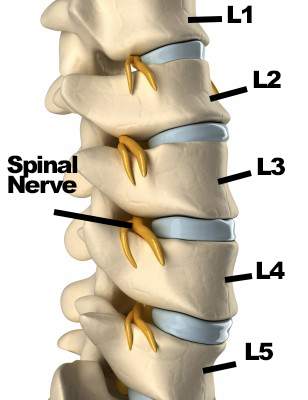
L4 and L5: Sciatica Exercises
So how do I know where my pinched nerve is? Two nerves come out between the last two vertebrae in your body. Your nerve is very commonly pinched here.
Your lower back vertebrae are called lumbar vertebrae. There are 5 vertebrae in the lower back. Taking the “L” for the lumbar spine, they are named L1, L2, L3, L4, and L5. The last two vertebrae in your lower back are L4 and L5.
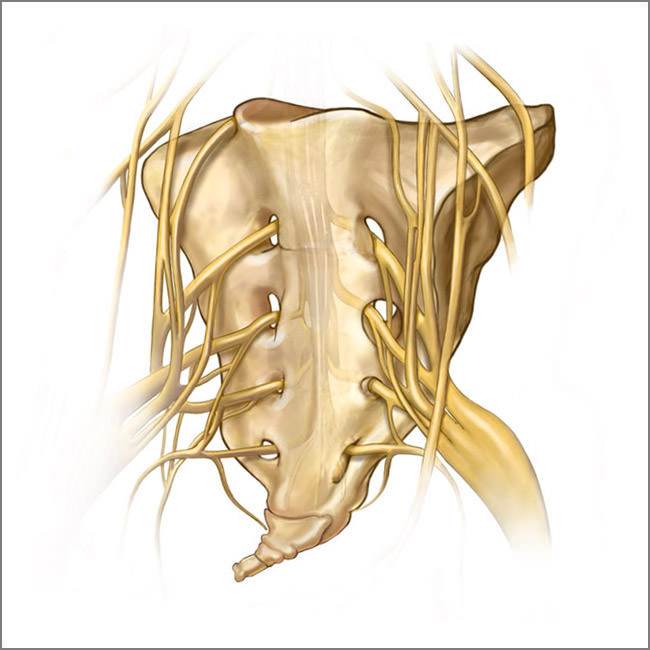
Ion medical designs http://www.ionmedicaldesigns.com/ion_site/two_dimensional_artwork.html
Just below L5 is one of your pelvic bones. It’s called the sacrum. The sacrum has holes with yellow-coloured nerves coming out.
S1, S2, S3: Sciatica Exercises
The nerves are called S1, S2 and S3. “S” is for sacrum. These nerves are rarely pinched.
Your sciatic nerve is formed when the nerves from L4 L5 and L5 S1 join together with the S1, S2 and S3 nerves in your buttock.
So, most of you will have your nerve pinched in one of three spots.
- In the buttock the Sciatic Nerve starts, in other words where the S1, S2, and S3 nerves join the two other nerves that come out between L4, L5 and L5 S1.
- Between L4 and L5 vertebrae
- Between L5 and S1 vertebrae
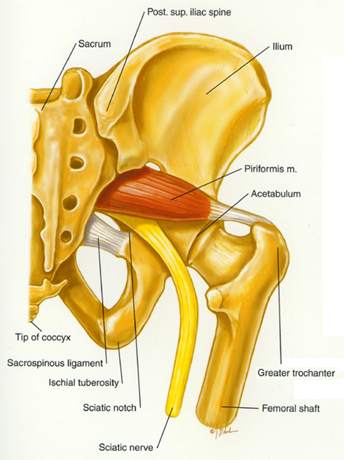
Now you know where the nerve can be pinched but it doesn’t answer why one of the nerves is pinched causing your sciatica
The Usual Suspects (Causes) of Sciatica
Most people’s sciatica is from:
- Herniated Disc at L45 or Herniated Disc at L5S1 (some osteoarthritis = “wear and tear” is involved)
- Degenerative Disc Disease (Osteoarthritis of the Disc=”Wear and Tear” of the Disc)
- Stenosis (Basically advanced osteoarthritis)
- Spondylolisthesis (A fracture of the vertebra or Osteoarthritis with the vertebra moving forward)
- Piriformis Syndrome
These are the diagnoses that your doctor or chiropractor should be telling you about not sciatica.
Remember sciatica only says that you have a pinched sciatic nerve causing pain in your buttock and leg, sciatica doesn’t tell you the cause of your pain. Without determining the cause you will get hit-or-miss treatments from your chiropractor or physiotherapist as they can’t give you specific treatment.
See Also: MRI CT scans X-rays, What’s Best For My Pain
The key exam that you need to determine what the heck is causing your pain is a neurological examination. You have probably seen it on TV before.
- Reflex tests with a reflex hammer on your knee and the back of your ankle
- Muscle Strength Testing: Resisted muscle testing of your foot. You try and push up/down while the chiropractor holds your foot. An alternative is heel walking and walking on your toes.
- Light Touch and Sharp Dull Testing: A light touch directly on the unclothed legs and feet to determine if you are unequal in your sensitivity to light touch and sharp/dull testing. A light touch is often enough as a screening.
Also, remember that the diagnosis should pretty much be determined in the office and X-rays, MRI, and CT scans done only if there are signs of something else or the diagnosis is kind of fuzzy.
See Also: Herniated Disc Part 2: The Best Exercises For Your Herniated Disc
Herniated Disc: Sciatica Exercises
You herniate a disc from the everyday habits that you have. The everyday habits of slouching and bending with a rounded low back, build up to weaken and damage the disc to the point it is ready to break open and herniate.
The problem is there is no pain. You don’t feel sciatica until the disc has herniated as there are no nerves inside the disc. So you continue your habits and think you don’t have a bad back until one day you lift your daughter off the floor.
The only problem is you had a bad back with no symptoms for a very long time. This is just like a car with a little bit of rust showing but if you take the car apart you see a lot more rust.
Degenerative Disc Disease – Osteoarthritis of the Disc
Degenerative Disc Disease is a continuation of the breakdown of the disc that was started by bad lifting and slouching habits.
The disc becomes smaller, and brittle like an old elastic band that is decaying, leading to the disc becoming smaller in height. The smaller disc makes the space between the vertebrae smaller. Thus, your nerve doesn’t have much room, so your nerve gets pinched between L4 and L5 or L5 and S1.
Stenosis- Most commonly from continuation of Osteoarthritis
Stenosis is a “narrowing”. There are two types of stenosis
- Lateral Stenosis
- Spinal Stenosis
1. Lateral Stenosis is the narrowing of the hole which the nerves from the spinal cord come from. Does this sound familiar? It’s degenerative disc disease + the bone degenerating forming spurs that narrow the hole for the nerve. A smaller hole for your nerve eventually means a pinched nerve.
2. Spinal Stenosis is the narrowing of the canal where the spinal cord sits. This is essentially pinching of the spinal cord usually in the lower back.
Spondylolisthesis (Vertebebra moving forward)
Spondylolisthesis is usually the moving forward of the vertebra (sometimes backwards). When the vertebra moves forward the spinal cord and nerves are pulled putting tension on your nerve. Nerves under tension get irritated and so turn into sciatica. This can happen from a fracture to the vertebrae or osteoarthritis.
Piriformis Syndrome
Most people’s sciatic nerve usually goes over or under the piriformis muscle. In some cases, possibly yours, the sciatic nerve goes right through the piriformis muscle. When the muscle tightens up it squeezes on the sciatic nerve causing sciatica.
Walking like a “man” is another reason for sciatica. That’s right, when you walk bow-legged with your feet turned can give you trouble later.
Chances are, if you are reading this you already have a problem with sciatica. When you turn your feet out this makes the piriformis muscles work harder.
The harder your piriformis works the more likely the nerve will be pinched causing sciatica.
The 4 Best Exercises For Sciatica
While treatments are different for sciatica depending on the cause you can still help your chiropractor or physiotherapist by doing your home exercises.
1. Flossing: first introduced by Michael Shacklock
Flossing is good for your teeth but a different kind of flossing is good for your spine and spinal hygiene.
First, determine if you can floss safely:
- Sit on a chair or relatively hard surface. Please don’t sit on the couch, it is too soft and will aggravate your lower back.
- Raise your painful leg to the point of pain and keep it there.
- Bend your neck forward till your pain is aggravated from above
- Lower the leg till the pain decreases.
If the pain decreases you are safe to do flossing.
Warning: This exercise can cause acute sciatica but chances are minimized by doing the screening exercise. Don’t floss until you have been out of bed for at least 2 hours. Now The Flossing:
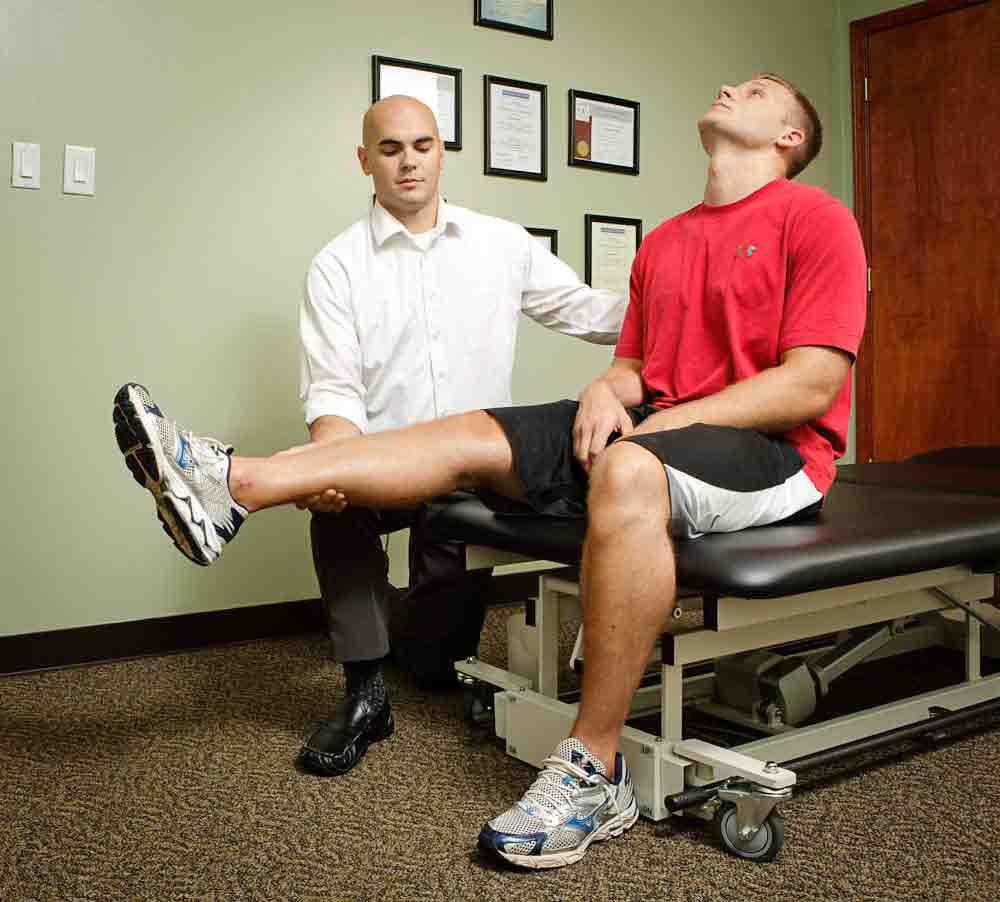
- Sit down in a chair with your legs swinging freely
- Bend your neck forward for 5 seconds (if this doesn’t cause sciatica you can do the next step)
- Bend your neck backwards as far as possible and straighten the knee (5 seconds)
- Repeat 3 sets of 10X on each leg. You can do this for up to 5/day.
2. Piriformis Stretch A) Sitting and B) Lying Face-Up
A: Sitting:
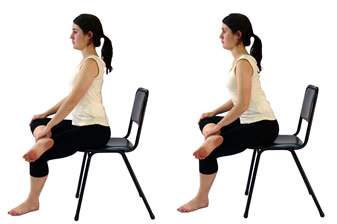
- Sit in a chair and cross the bad leg over the good
- Keep the arch in your back and move your chest forward
- Repeat 3 sets 30 secs. This can be done several times a day
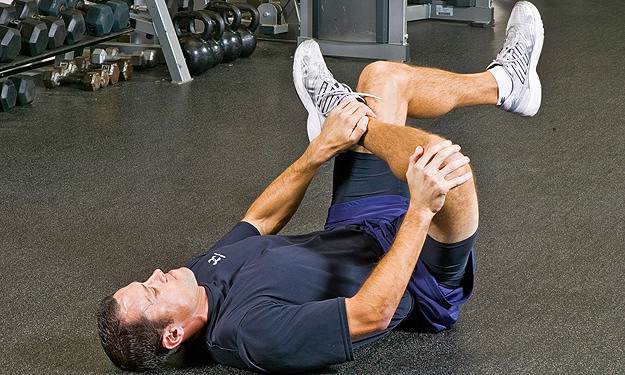
B: Lying Face-up: This exercise might be easier for some of you.
- Lying Face-up both knees bent. Put the bad leg over the good.
- Bring the good leg up to support the bad leg.
- Push the bad leg outward.
3. Ball Exercises: Piriformis, Gluteus Maximus, Gluteus Medius
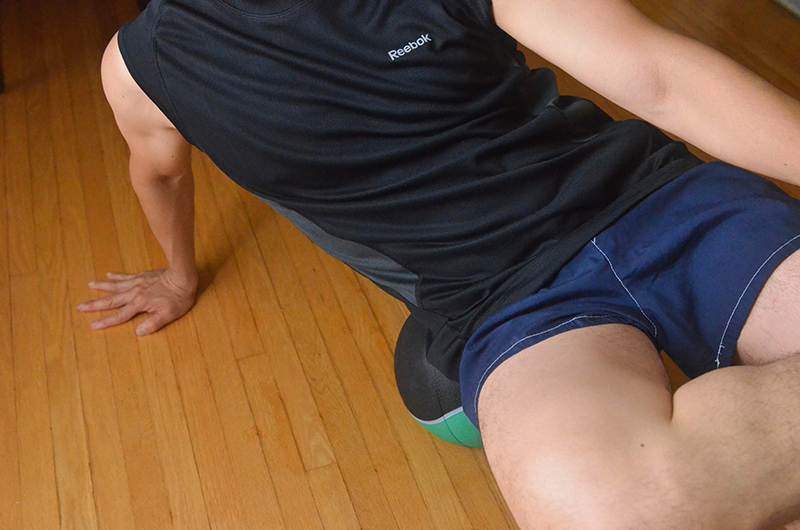
Piriformis
- Cross your bad side leg over the other knee
- Get a tennis ball, basketball or a medicine ball and sit on it with your buttock.
- To treat the piriformis go lean at about a 45-degree angle.
- Stop at each tender point and hold until each one is ironed out or feels less tender.
Gluteus Maximus
- Same as the piriformis except that you don’t need to cross the bad over the good.
Gluteus Medius
- Same as Gluteus Maximus except that you now lean at almost a 90-degree angle -You are almost on your side with a focus on the side area just below the belt or hip bone
4. Cobra
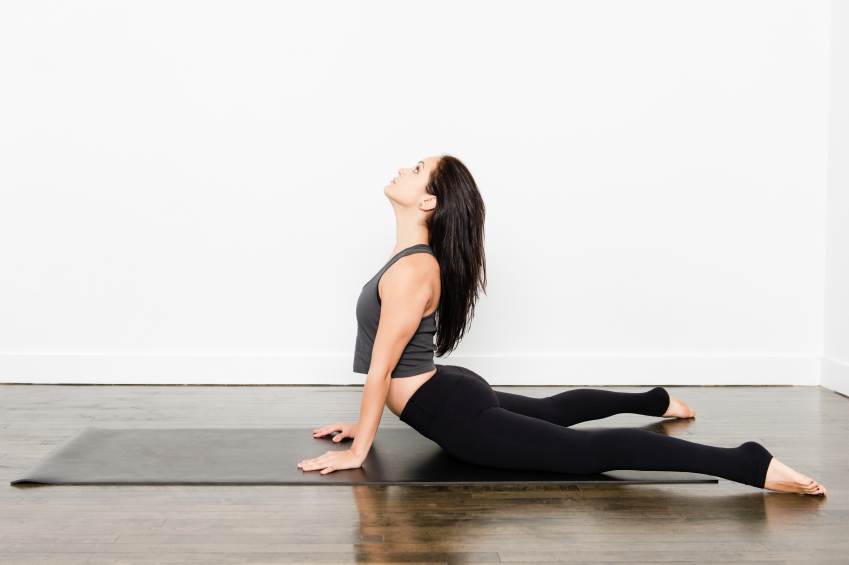
- Lie down face down with your hands underneath your shoulders.
- Push up from as high as you can until your lower back stops you or your elbows are straight.
- The pelvis should still be on the floor and the lower back muscles relaxed.
- Do these exercises hold each time for 1-2 seconds 6-8 times per set? This exercise can be repeated every two hours throughout the day.
If your pain is from a disc herniation you can combine the disc herniations part 2 exercises with these exercises. If your sciatica is from a different cause I will write about all the conditions that cause sciatica over time.
Write in the comments to tell us how you are doing with your sciatica. Also, let us know your vote for the best Toronto Chiropractor below. Connect with me on LinkedIn.
Related Categories: Disc Herniation, Elbow, Hip, Low Back Pain, Shoulder, Stenosis

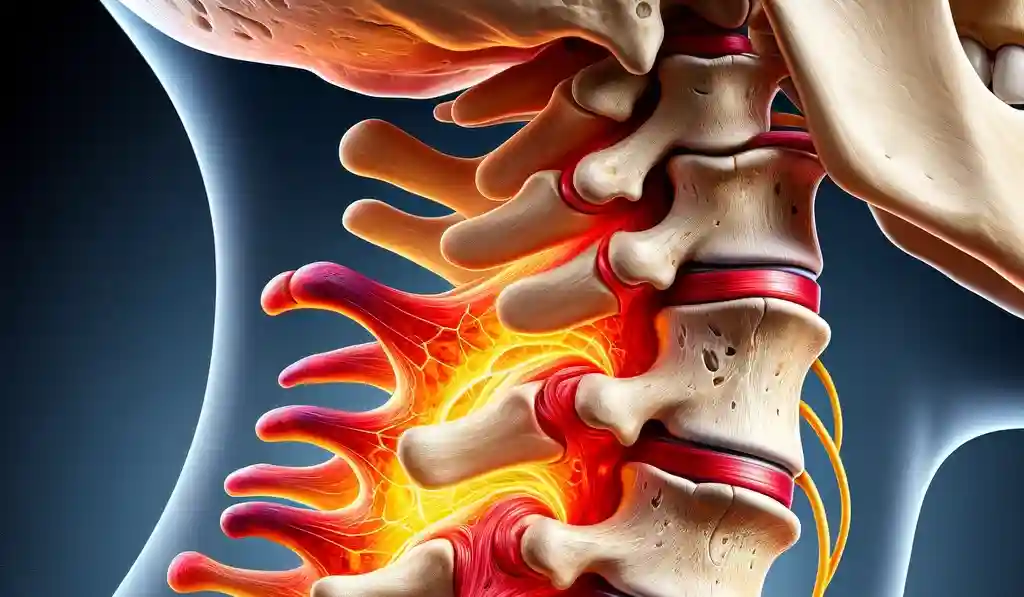


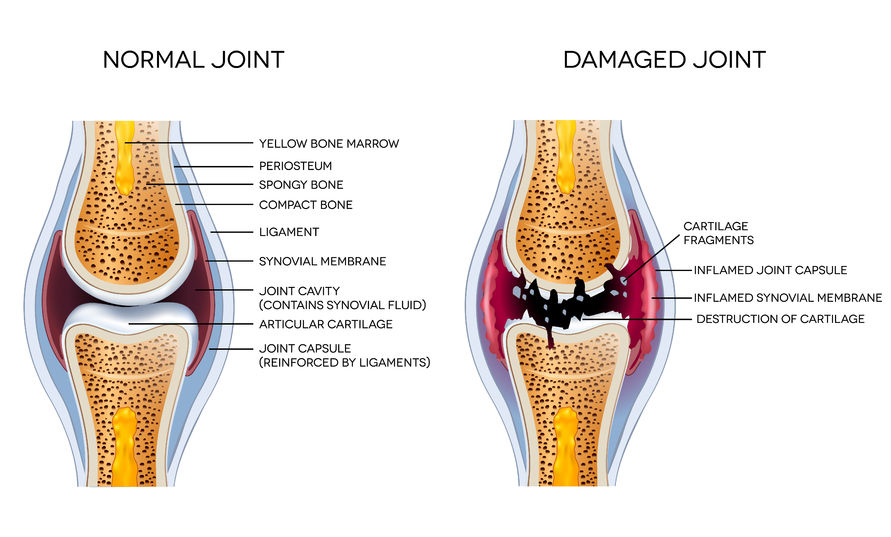
Respected sir,
I have disc bulge at L4-L5 postero central & right postero lateral disc bulge at L5-S1.
I feel pain on my back aur right butt and some on right leg also.. please help me sir I am just 21 years old. 🙁
Author
Thanks for your question Inder. Try these exercises if you have a disc bulge. https://www.bodiempowerment.com/herniated-disc-part-2-the-best-exercises-for-your-herniated-disc/
Also the exercises in this article are also helpful.
Hope that helps your L4-L5 postero central and L5-S1 postero lateral disc bulge.
sir i am 22 year old . i’ve severe pain in my lower back around L4-5 spine(no pain in legs) since last one year. after seing MRI Dr. says that your disc is dislocated. sir please guide about treatment and exercise .
Author
Thanks for your question Jagdish. I have never heard of a dislocated disc. I think you mean herniated disc. If that is what you mean than you should do these exercises.
https://www.bodiempowerment.com/herniated-disc-part-2-the-best-exercises-for-your-herniated-disc/
Hope that helps your herniated disc.
Sir good evening. You had suggested the exercises of my diagnosis(L5S1 & L4L5). I AM Doing all the exercises regularly. Now pain has decreased.But still I am feeling pain on my lowest most part of my thigh (just above my knee) after walking 2 kms and standing after 5 minutes. I also feeling pain after doing some physical work. Please please suggest me.
Author
Thanks for your question B N Sahoo. I recommended you do the exercises on November 26. It is about 2 weeks, so far. You need to patient. Most of these conditions takes months to heal. Even then you are not 100%. You might have no pain but your back is not 100%.
So stick with the exercises go back as far as you can with the extension and most of all be patient.
Hope that helps your disc herniation.
For the past few months, it has been increasingly difficult to get up out of bed in the morning. I feel like the tin man left out in the rain and I’m only 52. 🙁 I had back surgery in 2004 for a ‘huge’ herniation, according to the surgeon. I regained 100% movement, taking yoga and working out. Though still active, I have not been exercising much in the last couple of years. I began a stretching program a few weeks ago, and have found some relief. When I wake now, my stiffness is concentrated in the flat of my lower back, L3-L5, and feels almost triangular. The numbness once confined to my left foot is now in my left calf too. Often this numbness eases during the day. Any exercises I can do to target this ‘triangular’ area. If I sneeze in the morning, I feel like I am going to break in half. It’s awful.
Author
Thanks for your questions Carter. I would do these exercises https://www.bodiempowerment.com/herniated-disc-part-2-the-best-exercises-for-your-herniated-disc/. If the exercises give you sharp pain or make the pain go further down into your foot than you should stop.
In the morning while still in bed you should lie prone (face down) than get up on your elbows (sphinx) than do the cobra exercises before doing anything else.
You should also prevent problems by reading this article and practicing how to bend properly. https://www.bodiempowerment.com/disc-herniation-part-1/
Hope that helps your disc herniation with sciatica.
Thank u sir for listening my problem and giving the suggestion .
Author
You are welcome B N Sahoo.
Dr. Ken first of
all i thanks u for giving advice to the people.
Sir i am a soilor in indian navy. 3 months bofore While lifting weights i got heavy jerk in my left waist. It was very painful. After someday the pain slowly comedown to my same left low back. I did x- ray followed by MRI. My x ray report.- Reduced lumber lordoris para spinal muscle sparm.
My MRI Report(25.11.14) Broad based posterior protrusion with annular tear at L4-5 a long with thickened ligamenturn flavum mildly compressing the thecal sac; impinging on bilateral traversing roots, causing spinal canal stenosis and bilateral nural foraminalcompromise.
Broad based prosterior disc protrusion at L5S1 intending the anterior thecal sac and causing mild bilateral neural fora minal compromise…
Some days before i was feeling pain on my thigh and leg after walking 50m. And standing in 1min.
I was feeling pain after sleeping. I was feeling more pain in the early morng.
Now after taking medicine and complete rest , pain reduced. But now while i try to do sit up exercise, moving the leg to upward direction on sleeping , bending of toe .i was feeling pain on my low back.
Please please give suggest .
Author
Thanks for your questions B N Sahoo. You should never do sit-ups. They will increase your pain. Also bending forward to touch your toes it the wrong this to do. You need to these exercises. https://www.bodiempowerment.com/herniated-disc-part-2-the-best-exercises-for-your-herniated-disc/
Hope that helps your disc herniation.
Thanks Dr Ken this article on Si joint pain is very helpful! can Si Joint dysfuncation cause pins n needles it foot or stabbing pain in calf? Or does pain normaly stay above the knee. Thanks again!
Author
Thanks for your question Laura? Si pain can’t cause pins and needles or stabbing pain in the calf. The nerve is involved.
Try these exercises instead.
https://www.bodiempowerment.com/herniated-disc-part-2-the-best-exercises-for-your-herniated-disc/
Hope that helps your radiculopathy.
Hi Dr Ken ive been having doing Si joint exercises and piriformis stretches plus pelvic floor exercises for my left Si joint pain and leg pain now I’m getting pain in my right Si joint but my pain is improving on my left. My question is can exerciseing your core and pelvic floor muscles plus light piriformis stretches cause the ligaments around the Si joint to become stretched or are they to strong for this? Been doing exercises now for three months and pain has just started but very light. Thanks again for answering all my questions!
Author
Thanks for your question Laura. Just stretching your piriformis will not over stretch your SI joint but all kinds of things like crossing your legs while sitting and putting your leg underneath your buttock while sitting as a habit, will over stretch the ligaments.
A possibility is that you have compensated to the pain and now you are putting more pressure on your right as putting pressure on the left while you are walking and sitting is too painful. For more details I have just written this article. https://www.bodiempowerment.com/sacroiliac-joint-pain-4-exercises-sacroiliac-joint-dysfunction/
Hope this helps your SI joint pains.
Hi Sir,
Would really need your advice and help for the worries that I’m having.Im 26 years of age.Had been having left lower back pain for past 1 year,went to checked,doctor then ordered for an Mri.
Mri results shows that my L5 /S1 has degenerative disc desease and also posterior annular tear.Doc then refered me to physio theraphy soon.Am now having slight numbness at my left big toe and also slight bum type of pain at my upper feet.Any ways this problem can be fixed or healed permanently?Any supplements to be taken that can help to heal the annular tear?
Appreciate your advice Dr.
Thank you Sir for your Help
Author
Thanks for your question Mohamed. First Mohamed you should try these exercises https://www.bodiempowerment.com/herniated-disc-part-2-the-best-exercises-for-your-herniated-disc/ and the exercises here in this article later on.
Supplements won’t help heal the annular tear, it doesn’t heal. However you can at least help put the disc back in with exercises.
Hope that helps your degenerative disc disease and disc annular tear.
sir I have got mild broad posterocentral disk protrusion at l5-s1 causing mild bilateral transversing s1 nerve root compression,,, that’s what MRI results shows ,,,,,recommend me some exercises ,,,although there is lot of improvement as I had bed rest fr a while nw , I am 19 years old sir
Author
Thanks for your question Ummer. Try these exercises. https://www.bodiempowerment.com/herniated-disc-part-2-the-best-exercises-for-your-herniated-disc/
Hope that helps your disc protrusion.
Dear Dr Ken,
It has been like two months i have weakness and numbness in my left leg, the numbness was in my foot and toes but after after doing some exercises and PT it left there but it does not disappear from my calf.
I did MRI test the reports says: Parasthesia, Low Back Pain Radiating to left lower leg and foot. MRI study of the lumbar spine shows mild diffuse annular bulge of L5 S1 disc with no pressure effect of the thecal Sac or foraminal compromise. rest of the disc have normal appearance. I would appreciate if you could advice me, on what to do. Thanks you,
Author
Thanks for your question Nazeer. Why don’t you try these exercises as long as they don’t give you sharp pain. They don’t cause pain to go further down the leg and you don’t get pain for more than 1/2 hour.
https://www.bodiempowerment.com/herniated-disc-part-2-the-best-exercises-for-your-herniated-disc/
Hope that helps your disc bulge.
Dear Sirs,
My Wife is suffering from lower back pain due to L5 degeneration, please suggest the exercise for her or any treatment.
BR
Vipin Gupta
Author
Thanks for your question Vipin. Here are the exercises for degeneration.
https://www.bodiempowerment.com/part-2-degenerative-disc-disease-exercises-help-lower-back-pain-spondylosis
If she has sciatica than she should do the exercises in the article you are reading. “Sciatica: The 4 best exercises for people with sciatica”
Hope that helps her degenerative disc disease.
Dear Dr. Ken
I am 28 yrs old and recently got my back’s MRI done and the reports says:
* There is straightening of lumbar curvature
* The L4,L5 and L5 S1 shows dessicative changes.
* diffuse disc bulge with posterior annular tear and posterocentral / right paracentral
* diffuse annular bulge with posterior central disc protrusion at l5 s1 effacing the anterior epidural fat and indicating verbal theca
Thank you so much for your prompt response. Extension doesn’t bother me at all when I do them. Pain only comes maybe a day later and then I cannot tell exactly which exercise caused it. I didn’t have an accident nor am I a dancer or a gymnast! I think I injured myself doing strength training with kettle bells but I will never know for sure because I only experienced an incident of acute pain while bending over to shave my legs one day! Suddenly I heard a pop and it hurt to bend over for two weeks, the pain gradually changed into nerve pain radiating down my kegs causing all types of weakness and nerve sensations in my body. That’s when I did the MRI. It’s been a challenge to figure out the correct course of treatment through PT ever since. Your website is such a wealth of information and you explain things so well, I was hoping you could tell me if building core strength and flexibility is the way to go or if I needed a more specific type of treatment. I realize though there is only so much you can tell via email. Thank you for your insights!
Author
Thanks for your questions Talia. You should watch out when you build core strength and flexibility is not what you want. Make sure the core exercises that you do aren’t hurting you. I would just try do the extension exercise only to see if they are helping you or hurting. This way you are isolating the exercises. Off course if you end up doing a lot of flexion through the day that might be what is causing the problem.
You should read this article to help avoid the flexion in your spine if you are trying to treat the herniation. https://www.bodiempowerment.com/disc-herniation-part-1/ Remember flexion is need for the spondylolisthesis and extension for most disc herniations. You are assumming that the spondylolisthessis isn’t symptomatic for the moment.
The article in the link talks about how to stop aggravating yourself for a disc herniation. Make sure you do things under the guidance of a physio or chiro as I am only giving you an opinion.
Hope that helps your disc protrusion.
Hi Ken,
I am a fit, active 43 year old woman diagnosed in July with L5-S1 Spondylolithesis (grade 1 anterolisthesis) with bilateral pars defects and a 3mm disc protrusion with annular tear. I have tried regular PT with exercise for strengthening and flexibility and icing / heat as well as manual bodywork such as ART. But every time I feel like I am improving I seem to have a set back for no reason. I am so careful with my movements and so diligent about my so exercises and do lots of walking but the the nerve pain in my buttocks and legs along with soreness in my back and random nerve sensations in my hands and feet are getting me down. I just want to see progress and know that I am on the right track. In your opinion, what would be the best type of treatment to get back to 100%? Have you seen patients like me recover successfully? How long should it take? I have been struggling for almost 5 months now and desperately want my life back!
Thank you for any advice or guidance you can give me,
Talia
Author
Thanks for your question Talia. Sounds like you have a difficult problem. First you should know that a lot of disc protrusions don’t give you pain. Having said that some spondylolisthesis don’t give you any pain. You can have either of those conditions with no pain. The question is which one or both is giving you the problem. An MRI won’t be able to tell.
In your case with an annular tear it is more likely that the disc is giving you problems. Providing the spondylolisthesis is non-symptomatic you can do extension exercises. If the spondylolisthesis is giving you pain you will quickly feel the pain. If you feel sharp pain or increasing pain that lasts after doing the extensions than the exercises are not for you. Please note that the normal thing to do is flexion exercises for spondylolisthesis and extension for disc protrusions (normal posterior or posterior lateral disc protrusions) Just touch the pain don’t go through the pain when doing the extensions. When you do an extension you will start to feel some pain in your back you should stop about there. If the pain starts going further down the leg the exercises are not for you.
In your case you need to be guided by your physio or a chriorpactor when doing this otherwise you can run into problems as you have a complex problem.
I am guessing you had an accident or danced or did gymnastics.
Hope that helps your disc protrusion and spondylolisthesis.
Hi Dr Ken
I was woundering if it’s safe for me to use a rowing machine to help keep the pounds of while I can’t go running yet. I’m not sure if it’s Si joint dysfuncation or pirformis sydrome that I have, so would it be safe to use a rowing machine if I had those problems? I’m loving the pirifomis exercises you told me do and feeling like my pain is getting a little better. Thanks again laura.
Author
Thanks for your question Laura. Glad that the piriformis exercises are helping. I would keep doing them as long as they are working.
Hope that helps.
Hello doctor ,
I am really happy to see that you have answered all the queries of people out there , i am 32 years single female , and i weigh 75 kgs , weight increase is due to medicines for low vitamin b12 and vitamin d levels , i strongs want to loose weight and i joined a gym few days back but could not go after a week due to my cervical pain , my neck muscles and area around shoulders gets
muscle knots, spasms and i start feeling dizzy , my mri states THERE IS REVERSAL OF CERVICAL CURVATURE WITH NORMAL VERTEBRAL ALIGNMENT , DISC HYDRATION IS REDUCED AT VARIOUS LEVELS WITH MILDLY COMPROMISING THE THECAL SAC , WITH No SIGNIFICANT NEURAL FORAMINAL /SECONDARY CANAL COMPROMISE AT THESE LEVELS , MY doctor says ur problem is not something to worry , but whenever i do something tedious i feel dizzy , and there is pain n swelling in my muscles , i also feel i have sciatica as i feel pain in my right leg at times dob know may b the shoulder pain is radiating , please sir help me to make my neck muscles strong so that u can go gym and reduce weight , i just started with half hour cardio only but i had to stop , ur answer will b a great help .
Author
Thanks for your question Chamandeep. From what you tell I cannot see if your sciatica is related to your neck problem. If it is then you have a myelopathy which is pressure on the spinal cord. You do have pressure on your spinal cord in your neck but you need substantial pressure in your neck to cause sciatica down your leg.
If I were in your position I would get a second opinion from someone that will examine both your neck and lower back to see if they are connected. It’s true that osteoarthritis or neck wear and tear visible on MRI is normal in most people. The problem is at 32 years of age level of osteoarthritis is significant. If you ever had a trauma to your neck such as falling down from a ladder or a car accident this can result in these problems.
Sorry that I cannot help you but your problem needs to be examined in person.
Hope you get help for your neck problems and sciatica.
Cheers Ken, thanks for the time you take out your day to answering are questions.
Such a selfless thing to do
Author
You are welcome Robert. Thanks for appreciating.
Hi Dr Ken, I have had my MRI scan results back today and they have revealed a prolapsed disc on l5 s1, she said the left side of the disc has cracked and the jelly substance has touched the nerve, she sounded positive I can get better through excercise, unfortunately my appointment is not till 24th just wondered if the Mckenzie press up is ok to do as the tear is on the left side, or would glides towards the door be better? Another question is I can’t straighten my left leg out above a meter if Im lyeing on my back, will I ever get this motion back?
Many thanks Rob.
Author
Thanks for your question Rob. Sounds like you have tension in the nerve from the disc prolapse at L5S1. This is commonly helped by the exercises here but also in this article.
https://www.bodiempowerment.com/herniated-disc-part-2-the-best-exercises-for-your-herniated-disc/
I would do the exercises in the link above first. As long as you are not getting sharp pain or increasing pain or pain that lasts more than 1/2 hour after doing the exercises.
Hope that helps your disc prolapse.
Thanks again for your time!